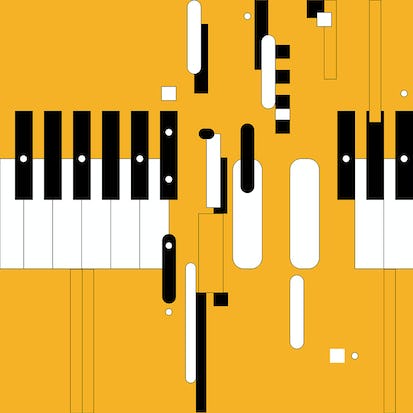- Level Professional
- المدة 22 ساعات hours
- الطبع بواسطة California Institute of the Arts
-
Offered by

عن
This course is about how music works. It is about the relationship between the technical and aesthetic details of music. It is also about how developing a meaningful theoretical vocabulary can help you think and talk about musical style, and how learning that vocabulary can expand your appreciation for music. In this course you will learn music theory not by looking at theory itself, but by listening to, looking at, and"yes!"writing your own musical examples. By hearing, seeing, and writing yourself, you will learn about classical, modern, ancient, pop, jazz, and folk styles. Through lectures, relevant examples, and numerous practice assignments, we will examine fundamental aspects of melody. We will move into working with two voices and counterpoint, and finally to three voices and the beginnings of harmonic function. This is an intermediate-level course for musicians and composers who already have some understanding of music theory through previous study. If you are a musician or composer looking to build a deeper understanding of music theory for composing, performing, or improvisation, you have come to the right place. If you are an amateur lover of music or, perhaps, play a musical instrument and want to develop a deeper sense of appreciation for music theory, aesthetics, and history, you are also in the right place!
الوحدات
About the Course
1
Videos
- Welcome to the Course
9
Readings
- Is this course right for you?
- How to Pass This Course
- Accessing Music in the Course
- Instructor Presence and Staff Support
- Forum Guidelines
- Requesting Peer Reviews
- Academic Integrity
- About Performing
- About CalArts and the School of Music
Useful Information
1
Readings
- Week 1 Glossary & Playlist
Case Study: Psalm 148
1
Assignment
- Reinforce Your Knowledge: Remember New Terms
1
Discussions
- Notation Systems
7
Videos
- Let's Talk About Music
- The Richness of Simplicity, part 1
- The Richness of Simplicity, part 2
- Context and Discrete Function
- Neighbor Notes and Passing Tones
- Context Gives Notes Function
- Cadences
5
Readings
- Optional Practice: Medieval Notation
- Optional Practice: Modern Notation
- Optional Practice: MIDI Notation
- Some Lessons Learned
- Optional Practice: Antiphon
Try it Yourself: Write a Gregorian Chant
1
Peer Review
- Write a Gregorian Chant (Optional)
1
Videos
- How to Grade: Write a Gregorian Chant
Case Study: Blue in Green
6
Videos
- An Utterly Different Aesthetic, part 1
- An Utterly Different Aesthetic, part 2
- Leaps vs. Steps
- Chromaticism: Outside Notes
- The Next Chromatic Note
- Sequence
3
Readings
- Optional Practice: Improvise a Melody
- Optional Practice: A Little Musical Idea
- Some More Lessons Learned
Try it Yourself: Write a Slow Jazz Song
1
Peer Review
- Write a Slow Jazz Song (Optional)
1
Videos
- How to Grade: Write a Slow Jazz Song
Test Yourself
2
Assignment
- See it then Hear it: Over the Rainbow (Required)
- Hear it then See it: White Christmas (Required)
Case Study: Folk Songs (Honors Lesson)
1
Assignment
- See it then Hear it: The Riddle Song (Required - Honors)
1
Peer Review
- Write a Folk Song (Optional - Honors)
1
Videos
- How to Grade: Write a Folk Song
2
Readings
- Talking About Folk Music
- Examples of Folk Music
Useful Information
1
Readings
- Week 2 Glossary & Playlist
Case Study: Mozart's Piano Sonata
2
Videos
- Complex Simplicity: Repetition and Expectation
- Repetition
1
Readings
- Some Lessons Learned
Try it Yourself: Write like a Classical Composer
1
Peer Review
- Write like a Classical Composer (Optional)
1
Videos
- How to Grade: Write Like a Classical Composer
Case Study: Chopin, Withers, Ives
3
Videos
- Less is More: Chopin
- Less is More: Ives
- Some Lessons Learned
5
Readings
- Listen First: Chopin, Withers, Ives
- Less is More: Withers
- Optional Practice: I Want You
- Optional Practice: One Note Samba
- Optional Practice: Musica Ricerata
More and More Chromatics
4
Videos
- Brahms Rhapsody
- Schoenberg's Piano Concerto
- Single Ladies / It's a Small World / Your own personal nightmare earworm
- Three Expansive Tunes
1
Readings
- Listen First: Brahms & Schoenberg
Try it Yourself: More Writing!
3
Peer Review
- Write like a Romantic Composer (Optional)
- Write like an Early 20th Century Composer (Optional)
- Write an Earworm (Optional)
3
Videos
- How to Grade: Write Like a Romantic Composer
- How to Grade: Write like an Early 20th Century Composer
- How to Grade: Write an Earworm
Test Yourself
2
Assignment
- See it then Hear it: Diaphonic Suite #1 (Required)
- Hear it then See it: Mon coeur s'ouvre a ta voix (Required)
Not Everything is Analyzable (Honors Lesson)
1
Assignment
- See it then Hear it: 1- (Required - Honors)
2
Peer Review
- Write like a Mid to Late 20th Century Composer (Optional - Honors)
- Write like a Wombat (Optional - Honors)
4
Videos
- Boulez, Selon Pli
- John Cage's Atlas Eclipticalis
- How to Grade: Write Like a Mid- to Late 20th Century Composer
- How to Grade: Write Like a Wombat
Useful Information
1
Readings
- Week 3 Glossary & Playlist
Consonance and Dissonance
1
Assignment
- Physical Consonance (Required)
1
Discussions
- Contrasting Emotions
6
Videos
- Introduction to Consonance and Dissonance
- The Physics Of It All
- The Culture & Context You Swim In
- The Functional Relationship
- A Three-Minute History of Medieval Music
- A bit more about medieval music—and meter
1
Readings
- Optional Practice: Meter
Common Practice Consonance
4
Videos
- Introduction to 'The Rules'
- A Simple Explanation of Counterpoint, part 1
- A Simple Explanation of Counterpoint, part 2
- Adding Dissonance
Try it Yourself: Counterpoint
2
Peer Review
- Counterpoint Assignment, Part One: A&B (Optional)
- Counterpoint, Part Two: C&D (Optional)
2
Videos
- How to Grade: Counterpoint, Part One: A&B
- How to Grade: Counterpoint, Part Two: C&D
Josquin in Two Voices
2
Videos
- Josquin in two voices, part 1
- Josquin in two voices, part 2
2
Readings
- Optional Practice: An informal analysis of Josquin
- Optional Practice: Two Beautiful Pieces
Test Yourself
2
Assignment
- See it then Hear it: Broken Rules (Required)
- Hear it then See it: Broken Rules (Required)
Making the Rules (Honors Lesson)
1
Peer Review
- Counterpoint, Part Three: E&F (Required - Honors)
3
Videos
- Creatively Breaking Rules
- Breaking the Rules In Order To Make New Rules in Order to Figure Out What Rules Are
- How to Grade: Counterpoint, Part Three: E&F
Useful Information
1
Readings
- Week 4 Glossary & Playlist
Three Parts
2
Videos
- More Than Two Voices at a Time: The Beginnings of Harmony
- Demonstration: 3-part voice leading
Cadences
3
Videos
- Cadences, part 1
- Cadences, part 2
- Melodic Aspect to Cadences
1
Readings
- Listen to Haydn and Pärt
Harmonic Function
8
Videos
- Tonal Function
- More about the Leading Tone: A diversion into Rock and Country
- Rock/Pop vs. Country
- Getting back to Tonal Function: Subdominant
- Some simple examples
- Subdominant Feelz
- Recap of Harmonic Function
- All Triads in a Key
1
Readings
- Listen First: Stairway to Heaven & Coal Miner's Daughter
Analysis: Mozart Piano Concerto
3
Videos
- Mozart Piano Concerto, Part 1
- Mozart Piano Concerto, Part 2
- Mozart Piano Concerto, Part 3
Test Yourself
2
Assignment
- See it Then Hear it: Piano Sonata #1 (Required)
- Hear it and See it: Dove Sono (Required)
The End
1
Peer Review
- Final Assignment (Required)
2
Videos
- How to Grade: Complete the Cadences (Final Assignment)
- Conclusion
Honors Track Extension
1
Peer Review
- Final Assignment Extension (Required - Honors)
Auto Summary
Unlock the secrets of music with "Approaching Music Theory: Melodic Forms and Simple Harmony," an engaging course designed to deepen your understanding of the intricate relationship between technical and aesthetic elements of music. This course, offered by Coursera, invites you to explore a diverse array of musical styles, including classical, modern, ancient, pop, jazz, and folk, through a hands-on approach that involves listening, analyzing, and composing your own musical pieces. Led by expert instructors, this intermediate-level course is perfect for musicians and composers who have a foundational knowledge of music theory and seek to enhance their skills for composing, performing, or improvisation. It’s also ideal for passionate music enthusiasts and instrumentalists who wish to broaden their appreciation and theoretical knowledge. Over approximately 1320 minutes of immersive lectures, practical examples, and numerous practice assignments, you will delve into fundamental aspects of melody, progress to working with two and three voices, and explore the beginnings of harmonic function. Choose from Professional and Starter subscription options to tailor your learning experience to your needs. Join us in this comprehensive journey to elevate your musical expertise and appreciation!

Marc Lowenstein


